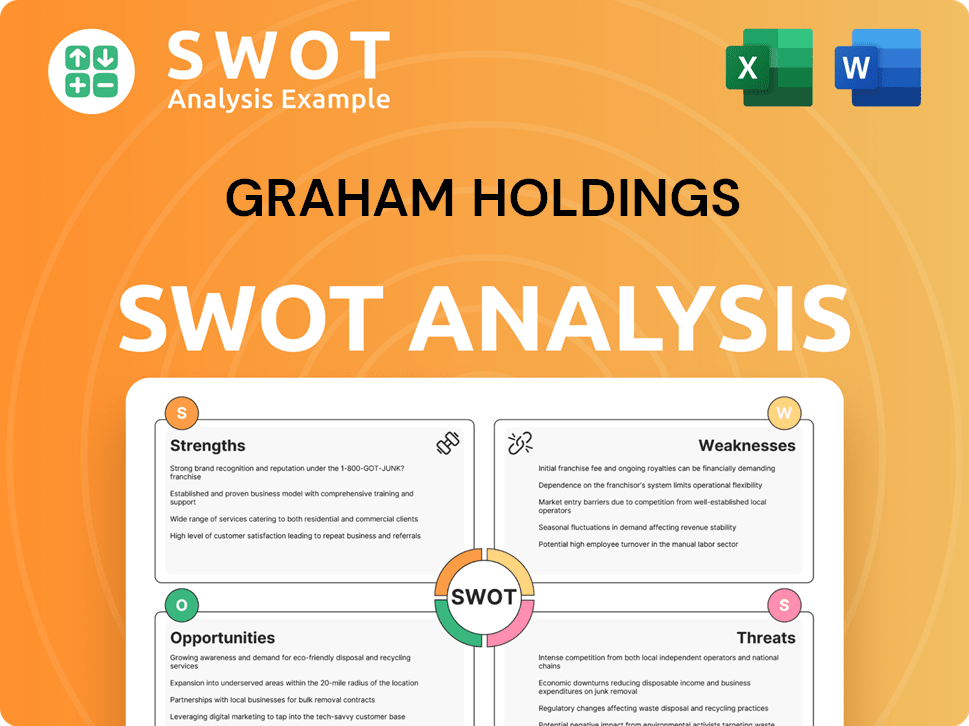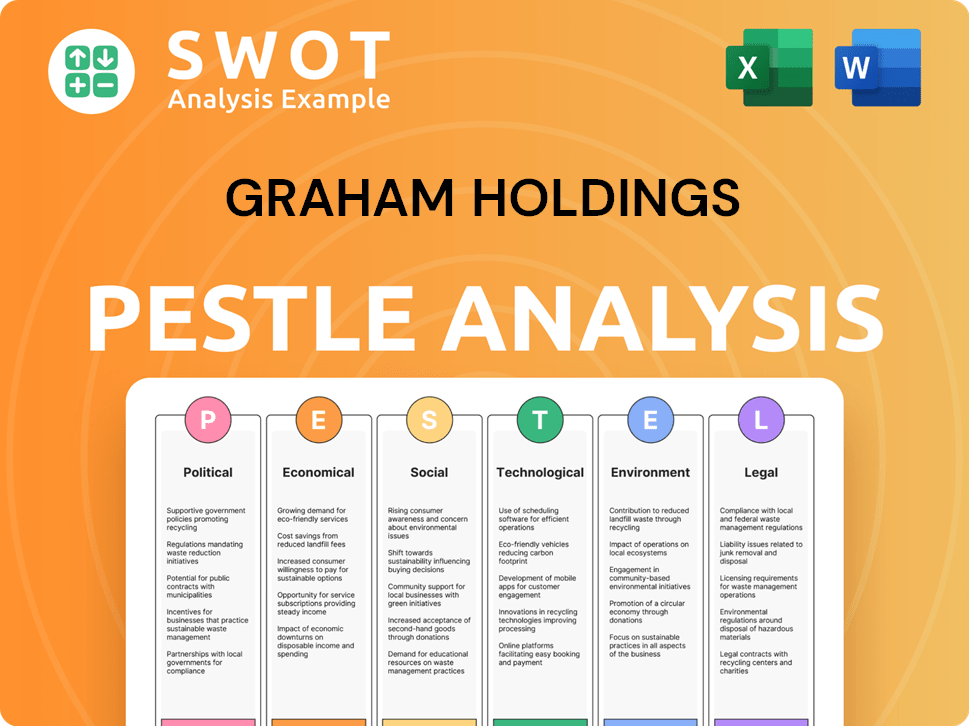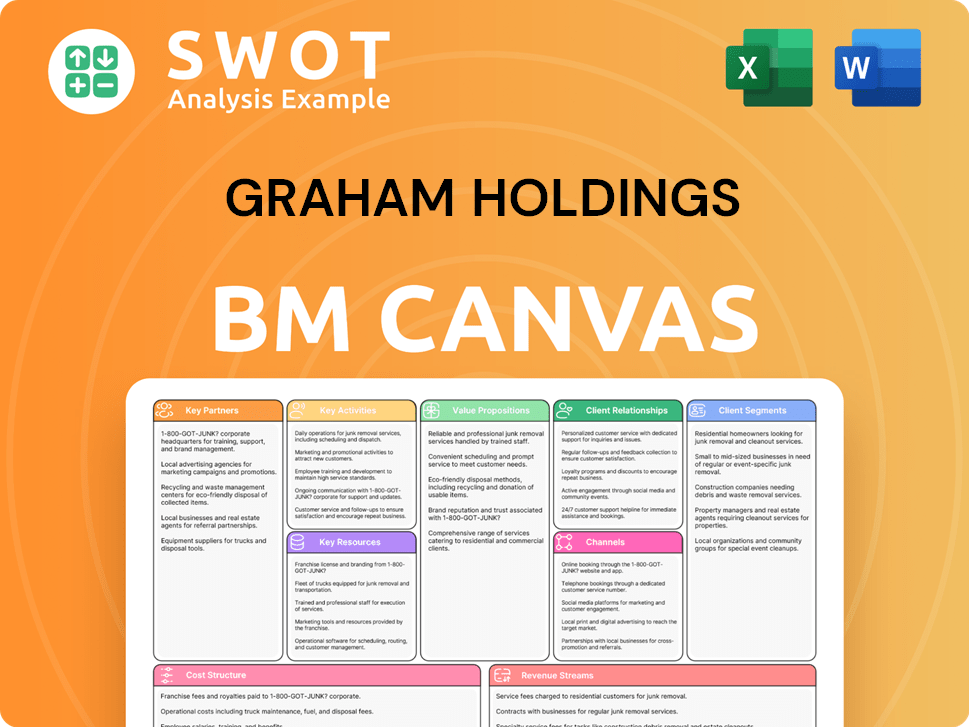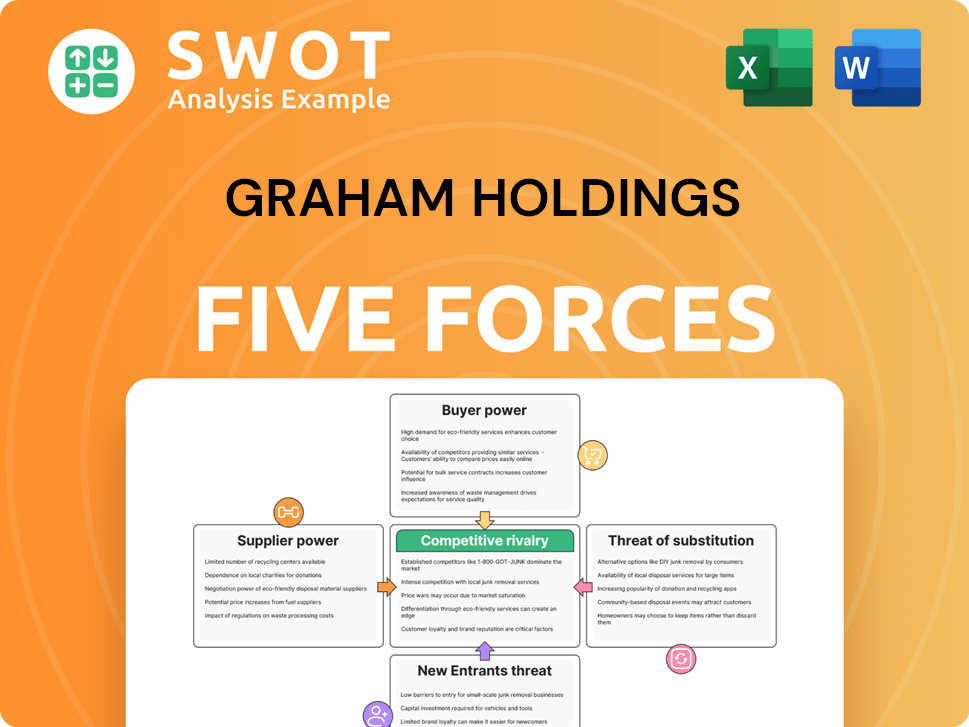Graham Holdings Bundle
How Does Graham Holdings Company Thrive in a Diverse Market?
Graham Holdings Company, a multifaceted entity with interests spanning education, media, and manufacturing, employs a dynamic sales and marketing strategy to navigate its diverse portfolio. From its roots in traditional media to its current expansive reach, the company's approach has continually evolved. Understanding its current strategies is key to appreciating its sustained success.

This analysis dives deep into Graham Holdings' Graham Holdings SWOT Analysis, exploring its sales and marketing approach across its various subsidiaries. We'll examine how Graham Holdings generates revenue, focusing on its marketing plan example and the competitive advantage it leverages. The study will also cover its customer acquisition strategies, advertising spend, and content marketing initiatives, offering insights into its financial performance and growth strategies within a competitive landscape.
How Does Graham Holdings Reach Its Customers?
The sales and marketing strategy of Graham Holdings Company is multifaceted, adapting to the unique characteristics of its diverse business segments. This approach involves a blend of online and offline channels, reflecting a strategic focus on reaching various customer bases effectively. The company's ability to leverage its established networks and adapt to evolving customer acquisition models is key to its success.
The company's sales channels are tailored to each business area, including educational services, television broadcasting, manufacturing, and healthcare. Each segment employs distinct strategies, from direct-to-consumer platforms to business-to-business sales and direct patient engagement. The evolution of these channels reflects a strategic shift towards digital adoption and omnichannel integration.
The company's revenue streams are diversified across its subsidiaries, supported by targeted sales and marketing efforts. The effectiveness of these strategies is reflected in the company's financial performance and market position. Understanding the sales channels provides insights into how Graham Holdings generates revenue and interacts with its customers.
Kaplan, the educational services arm, primarily utilizes direct-to-consumer online platforms and physical learning centers. The company's website acts as a central hub for course enrollment and information. Direct sales teams are crucial for corporate and institutional clients seeking customized educational solutions, with a significant shift towards digital adoption.
The television broadcasting division primarily focuses on advertising sales to local and national businesses. This involves direct sales teams working with advertisers and media agencies. They leverage the reach and demographic targeting capabilities of its owned television stations, which is a key part of the company's Graham Holdings sales strategy.
Manufacturing often involves direct sales to other businesses (B2B), potentially through specialized sales forces, distributors, and trade shows. Healthcare services typically involve direct patient engagement, often through referrals, and partnerships with insurance providers and healthcare networks. These channels are essential for understanding how Graham Holdings generates revenue.
The company is driving towards omnichannel integration where feasible, ensuring a cohesive customer experience across digital and traditional touchpoints. While specific partnership details for 2024-2025 are not publicly itemized for each segment, the success of Graham Holdings Company hinges on its ability to leverage established networks and adapt to evolving customer acquisition models.
The Graham Holdings marketing strategy emphasizes digital adoption, direct sales, and strategic partnerships. These strategies are designed to reach diverse customer segments and drive revenue growth. The company's approach reflects an understanding of its Graham Holdings target audience and the competitive landscape.
- Digital Marketing: Utilizing online platforms for course enrollment and information dissemination.
- Direct Sales: Employing sales teams for corporate clients and advertising sales.
- Partnerships: Collaborating with insurance providers and healthcare networks.
- Omnichannel Integration: Creating a cohesive customer experience across all touchpoints.
Graham Holdings SWOT Analysis
- Complete SWOT Breakdown
- Fully Customizable
- Editable in Excel & Word
- Professional Formatting
- Investor-Ready Format

What Marketing Tactics Does Graham Holdings Use?
The marketing tactics employed by Graham Holdings Company are diverse, reflecting its multifaceted business structure. The company strategically uses both digital and traditional methods to build brand awareness, generate leads, and boost sales across its varied portfolio. This approach is tailored to the specific needs of each segment, ensuring targeted and effective marketing campaigns.
For its educational division, Kaplan, digital marketing is the primary focus. This includes content marketing, search engine optimization (SEO), and paid advertising. Email marketing and social media engagement further support lead nurturing and community building. The company also leverages data-driven marketing for personalized course recommendations and to track student engagement.
In its television broadcasting division, the company uses a mix of traditional and digital marketing. Traditional methods include on-air promotions and local community events, while digital tactics involve social media and programmatic advertising. Manufacturing and healthcare businesses employ specialized tactics like industry publications, trade shows, and digital advertising to reach their respective target audiences.
Kaplan focuses heavily on digital marketing strategies to attract and engage students. This includes content marketing through blogs and webinars, SEO to improve organic search rankings, and targeted advertising on search engines and social media. Email marketing is also a key component for lead nurturing and student communication.
The broadcasting division uses a blend of traditional and digital marketing. Traditional methods involve on-air promotions and local events, while digital tactics include social media engagement and programmatic advertising. These efforts aim to increase viewership and attract advertisers.
Manufacturing relies on industry-specific publications, direct mail, and trade shows. Healthcare marketing includes patient education and digital advertising targeting specific services. These specialized approaches cater to the unique needs of each sector.
Data analytics plays a crucial role across all segments. Customer segmentation helps personalize marketing messages and course recommendations. Analytics tools are used to track student progress and engagement, ensuring campaigns are optimized for performance.
Social media is a key tool for brand building and community engagement, particularly for Kaplan. Active presence on platforms like LinkedIn, Facebook, and Instagram helps connect with potential students and alumni. This approach supports the overall Target Market of Graham Holdings.
The company's marketing mix is continuously evolving, with a strong emphasis on digital investment and data analytics. This shift allows for better campaign performance and personalization across all business segments. The focus is on optimizing the marketing spend to drive the best results.
The company's marketing strategy is designed to drive revenue growth across its diverse business units. The approach includes a strong emphasis on digital marketing, data analytics, and personalized customer experiences. This comprehensive strategy supports the overall Graham Holdings sales strategy and business objectives.
- Digital Marketing: Extensive use of SEO, content marketing, and paid advertising.
- Data Analytics: Employing customer segmentation and analytics to personalize marketing efforts.
- Social Media: Active presence on platforms like LinkedIn, Facebook, and Instagram.
- Traditional Media: On-air promotions and local community events are still used in broadcasting.
Graham Holdings PESTLE Analysis
- Covers All 6 PESTLE Categories
- No Research Needed – Save Hours of Work
- Built by Experts, Trusted by Consultants
- Instant Download, Ready to Use
- 100% Editable, Fully Customizable

How Is Graham Holdings Positioned in the Market?
The brand positioning of Graham Holdings Company is primarily driven by the distinct identities of its various subsidiaries, rather than a unified corporate brand. This approach allows each business unit to tailor its messaging and value proposition to its specific market and target audience. The company strategically leverages the established reputations and brand equity of its key subsidiaries, like Kaplan, to compete effectively in diverse and competitive markets. This decentralized strategy enables each brand to respond effectively to shifts in consumer sentiment and competitive threats within its respective market, leveraging its unique selling propositions to maintain relevance and appeal.
Kaplan, a significant subsidiary, is positioned as a trusted leader in educational services. Its core message revolves around empowering individuals to achieve their academic and professional goals, appealing to students seeking reliable and effective test preparation, higher education, and career development. Television broadcasting stations, another key area, focus on local community connection and reliable news delivery, aiming to be a trusted source of information for regional audiences. This localized approach allows each station to build strong relationships with its viewers and advertisers.
This strategy allows Graham Holdings to maintain a flexible and responsive approach to sales and marketing. By allowing each subsidiary to develop its own brand identity and marketing strategies, the company can adapt quickly to changing market conditions. This decentralized structure supports a robust Revenue Streams & Business Model of Graham Holdings, enabling each business unit to optimize its performance and contribute to the overall financial success of the parent company. This approach is particularly beneficial in today's dynamic media landscape, where consumer preferences and technological advancements are constantly evolving.
Kaplan emphasizes quality instruction and a strong track record of student success. Its visual identity and tone of voice are professional, supportive, and aspirational. Kaplan's brand focuses on empowering individuals to achieve their academic and professional goals, targeting students seeking test preparation, higher education, and career development.
Television stations focus on local community connection, reliable news, and entertainment. They aim to be a trusted source of information and reflect local values, appealing to regional audiences and local advertisers. This approach builds strong relationships with viewers and supports local advertising revenue.
These segments develop brand identities based on their specific industry niches. Manufacturing focuses on innovation and precision engineering, while healthcare emphasizes compassionate care and advanced medical treatments. This targeted approach allows each segment to build a strong brand presence within its respective market.
Brand consistency is maintained within each operating company across various channels and touchpoints. This ensures a cohesive brand experience for customers. This includes digital platforms and customer service interactions, reinforcing brand values and building trust.
The company's approach to brand positioning highlights its strategic focus on leveraging the strengths of its individual businesses. This strategy allows for flexibility and responsiveness in the market. The decentralized structure supports a strong Graham Holdings sales strategy and enables each business unit to optimize its performance.
- Focus on subsidiary brands rather than a single corporate brand.
- Emphasis on local community connection for television stations.
- Tailored brand identities for manufacturing and healthcare.
- Consistency in branding across all channels for each subsidiary.
Graham Holdings Business Model Canvas
- Complete 9-Block Business Model Canvas
- Effortlessly Communicate Your Business Strategy
- Investor-Ready BMC Format
- 100% Editable and Customizable
- Clear and Structured Layout

What Are Graham Holdings’s Most Notable Campaigns?
The Brief History of Graham Holdings reveals that the company's sales and marketing strategies are primarily driven by its diverse portfolio of subsidiaries. While a unified approach across all segments is less common, each subsidiary tailors its campaigns to its specific market and target audience. Kaplan, the educational services arm, consistently launches significant campaigns to drive enrollment and promote its offerings.
These campaigns often leverage digital platforms, targeted messaging, and a focus on measurable outcomes. For example, Kaplan's marketing efforts have historically emphasized online learning solutions, especially during critical periods. The goal is to ensure educational continuity and expand accessibility globally. This strategic focus is evident in the sustained growth of Kaplan's online enrollment, showcasing its ability to adapt and innovate in educational delivery.
The overall Graham Holdings sales strategy involves a decentralized approach, with each business unit developing its own marketing plan. This allows for flexibility and responsiveness to market dynamics. The Graham Holdings marketing strategy is designed to capitalize on the unique strengths of each subsidiary, driving revenue and enhancing the company's market position. The Graham Holdings business model relies on the ability of its subsidiaries to adapt to changing market conditions and effectively promote their products and services.
Kaplan's campaigns for online learning focus on digital advertising, content marketing, and testimonials. The objective is to highlight the effectiveness and accessibility of online education. These campaigns use social media, educational platforms, and direct email marketing. This strategy has contributed to the sustained growth of Kaplan's online enrollment.
Kaplan runs targeted campaigns for test preparation, such as for the SAT, ACT, LSAT, and GMAT. These campaigns use creative concepts to emphasize the benefits of Kaplan's courses, such as stress reduction and score improvement. Channels include targeted digital ads on educational websites, social media, and partnerships with schools and universities.
For its television stations, ongoing campaigns focus on promoting local news coverage and community events. The aim is to drive viewership and attract local advertisers. These efforts are crucial for maintaining audience engagement and generating advertising revenue. Local news remains a key element in the Graham Holdings media company strategy.
In its manufacturing and healthcare segments, campaigns are typically B2B focused, highlighting product benefits and service excellence. These campaigns use industry-specific channels and direct outreach. The strategy is to build relationships and demonstrate the value proposition of their offerings. This approach supports the Graham Holdings revenue generation.
Graham Holdings Porter's Five Forces Analysis
- Covers All 5 Competitive Forces in Detail
- Structured for Consultants, Students, and Founders
- 100% Editable in Microsoft Word & Excel
- Instant Digital Download – Use Immediately
- Compatible with Mac & PC – Fully Unlocked

Related Blogs
- What are Mission Vision & Core Values of Graham Holdings Company?
- What is Competitive Landscape of Graham Holdings Company?
- What is Growth Strategy and Future Prospects of Graham Holdings Company?
- How Does Graham Holdings Company Work?
- What is Brief History of Graham Holdings Company?
- Who Owns Graham Holdings Company?
- What is Customer Demographics and Target Market of Graham Holdings Company?
Disclaimer
All information, articles, and product details provided on this website are for general informational and educational purposes only. We do not claim any ownership over, nor do we intend to infringe upon, any trademarks, copyrights, logos, brand names, or other intellectual property mentioned or depicted on this site. Such intellectual property remains the property of its respective owners, and any references here are made solely for identification or informational purposes, without implying any affiliation, endorsement, or partnership.
We make no representations or warranties, express or implied, regarding the accuracy, completeness, or suitability of any content or products presented. Nothing on this website should be construed as legal, tax, investment, financial, medical, or other professional advice. In addition, no part of this site—including articles or product references—constitutes a solicitation, recommendation, endorsement, advertisement, or offer to buy or sell any securities, franchises, or other financial instruments, particularly in jurisdictions where such activity would be unlawful.
All content is of a general nature and may not address the specific circumstances of any individual or entity. It is not a substitute for professional advice or services. Any actions you take based on the information provided here are strictly at your own risk. You accept full responsibility for any decisions or outcomes arising from your use of this website and agree to release us from any liability in connection with your use of, or reliance upon, the content or products found herein.